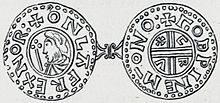Olaf Tryggvasson
| Olaf Tryggvason | |
|---|---|

Only known type of coin of Olaf Tryggvason, in four known specimens. Imitation of the Crux-type coin of Æthelred the Unready.
|
|
| King of Norway | |
| Reign | 995 – 1000 |
| Predecessor | Sweyn Forkbeard |
| Successor | Sweyn Forkbeard |
| Born | 960s Norway |
| Died | 9 September 1000 Svolder, Norway |
| Spouse |
Geira of Wendland Gyda of Dublin Gudrun Skeggesdatter Tyra of Denmark |
| Issue | Tryggvi the Pretender (possibly) |
| Father | Tryggve Olafsson |
| Mother | Astrid Eiriksdatter |
Olaf Tryggvason (960s – 9 September 1000) was King of Norway from 995 to 1000. He was the son of Tryggvi Olafsson, king of Viken (Vingulmark, and Rånrike), and, according to later sagas, the great-grandson of Harald Fairhair, first King of Norway.
Olaf played an important part in the conversion of the Norse to Christianity, often by forcible means. He is said to have built the first church in Norway (in 995) and to have founded the city of Trondheim (in 997). A statue of Olaf Tryggvason is located in the city's central plaza.
Historical information about Olaf is sparse. He is mentioned in some contemporary English sources, and some skaldic poems. The oldest narrative source mentioning him briefly is Adam of Bremen's Gesta Hammaburgensis ecclesiae pontificum (c. 1070). In the 1190s, two sagas of Olaf Tryggvason were written in Iceland, by Oddr Snorrason and Gunnlaugr Leifsson. Snorri Sturluson gives an extensive account of Olaf in the Heimskringla saga, (c. 1230), using Oddr Snorrason's saga as his main source. The accuracy of these late sources is not taken at face value by modern historians and their validity is a topic of some debate. The following account is mainly based on the late saga sources.
There is uncertainty about both the date and the place of Olaf's birth. The earliest Norwegian written source, the late 12th century Historia Norwegiæ, states that Olaf was born in the Orkney Islands after his mother fled there to escape the killers of Olaf's father. Another late 12th-century source, Ágrip af Nóregskonungasögum, says Olaf's mother fled to Orkney with Olaf when he was three years old, for the same reason. All the sagas agree that Olaf eventually ended up in Kievan Rus', at the court of King Valdemar.
...
Wikipedia
